#digital video disks
Text

Finished part 2 of Indigo disk DLC and had to draw this guy. 👹🫠✨
#pokemon kieran#artwork#art#animedrawing#anime#mangadrawing#manga#drawing#fanart#digital#procreate#pokémon violet#indigo disk#digital art#Pokémon#pokémon fanart#the hidden treasure of area zero#bb league champion#rival kieran#video game fanart#nintendo
518 notes
·
View notes
Text

There is so much drama with Kieran in the dlc!
#Pokemon#pokemon scarlet and violet#pokemon juliana#pokemon keiran#pokemon crispin#pokemon amarys#pokemon drayton#pokemon lacey#pokemon indigo disk#my art#fan art#digital art#video games
689 notes
·
View notes
Text
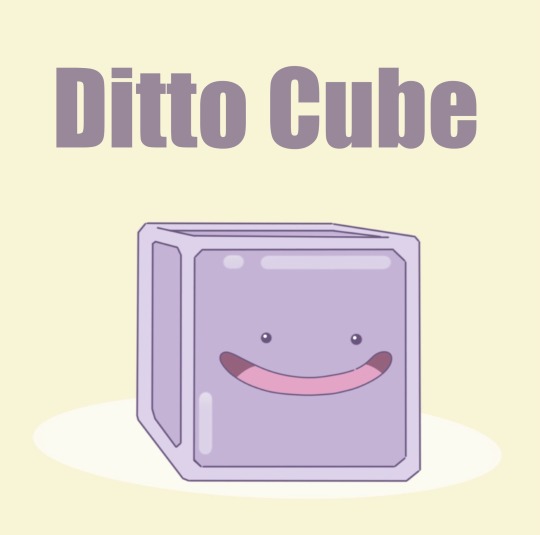

Ditto Cube
#cartoon#my art#video games#pokemon#nintendo switch#digital illustration#pokemon scarlet and violet#indigo disk#ditto cube
154 notes
·
View notes
Text
Metroid '86


#metroid#NES metroid#NES#video games#art#artists on tumblr#fanart#digital art#samus aran#samus fanart#famicom disk system#nintendo
47 notes
·
View notes
Text

i may have a problem
#i got the 2tb e drive less than 6 months ago#the problem is called 'into every digital creative pursuit on the planet'#kontakt libraries are disk space hell#and 3d art. and video games. and and and and#idk how people survive base drives less than 1tb 256gb is killing me#stable diffusion is awesome but fuckin conda eating like 20gb of c drive space
4 notes
·
View notes
Text
The Epitaph of Anything Goes

I decided that this morning I would talk about The Museum of Anything Goes and the subject of lost media.
For the uninitiated, The Museum of Anything Goes is an obscure "game" released in 1995 by Wayzata Technologies, a company that is so far under the radar that I was unable to find any useful information about it outside of TMoAG.
All I could uncover is that they published a few multimedia projects (which are essentially lost now) alongside some asset discs (clipart, SFX, etc.). That's it.
The brains behind Wayzata are even more difficult to locate these days: there are only two main names credited inside of TMoAG - Michael Markowski and Maxwell S. Robertson.
The game alleges that Michael and Maxwell are well known in the art world, but any additional information about the duo is scarce beyond the confines of the museum. Attempting to search for either name online turns up plenty of rabbit holes - but none of them have anything to do with the Michael and Maxwell responsible for TMoAG.

This is particularly fascinating because it essentially means that TMoAG is the only accessible record of their lives. Before we dig any deeper into that statement, let me step back and actually address what this game is.
The Museum of Anything Goes is, by definition, a virtual art museum. Functionally it's a prerendered point-and-click adventure game where you can explore a bunch of multimedia exhibits that give the surface-level impression of a children's edutainment game, but once you start exploring further it reveals a side that firmly plants the game's feet into a haze of substance abuse and surreal humor.

Many exhibits are essentially just toying around with the astonishing new powers of CD-ROM. Everything has to make noise. Everything has to spin and flitter around. There's an air of genuine excitement for the medium, and I can't help but find it extremely charming.
The game also functions as a scrapbook, filled to the brim with photos of random trips to the zoo and snow-mobile rides with friends. At one point we even get insight into something as specific as Michael's one-year job as a tutor at a Chicago middle school, where he talks about how it opened his eyes to how poorly funded and mismanaged the school system is.
It's simultaneously quaint and chilling to see so much personal history packed into a world doomed to obscurity. As I explore the deeper parts of the museum, I contemplate if the creators are still alive today. It's a bit morbid, but imagine that - you create a single obscure game with your friend and it's all the world can see. TMoAG is currently the only surviving piece that gives any insight into who these two men were.
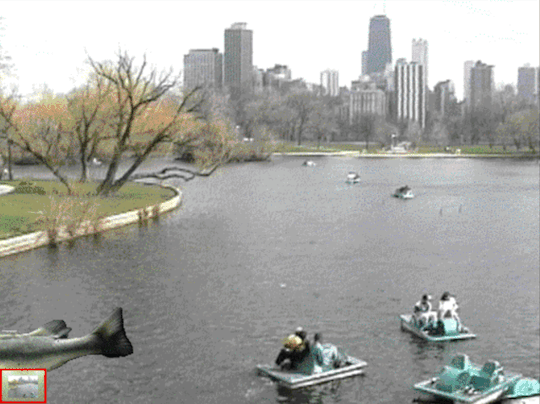
While many exhibits are lighthearted or nonsensical, there are occasional moments where the game dips into the eerie.
One exhibit has the player kill a man by dropping him from the sky, and after burying him you open the coffin to a video of a rotting pig carcass being put into an incinerator.
Other exhibits just feature simple 3D renders shifting around a dark screen while haunting groans play in the background.
While I would never refer to the game as "scary," its darker moments combined with the occasional mature subject matter definitely begs the question: Who is this game for?
You have to remember that this game came out long before the concept of "alt-games" had become codified in the digital space. Sure, unconventional digital art had been around before the advent of 256 colors, but TMoAG was being sold on disk as a game! It came out 2 years after DOOM hit shelves!
The trend of using the PC for entertainment was certainly on the upswing around that time, but It's not like TMoAG had a massive audience to find a niche in. With its mature themes it certainly wasn't suited for the kids market either, so who was it for?
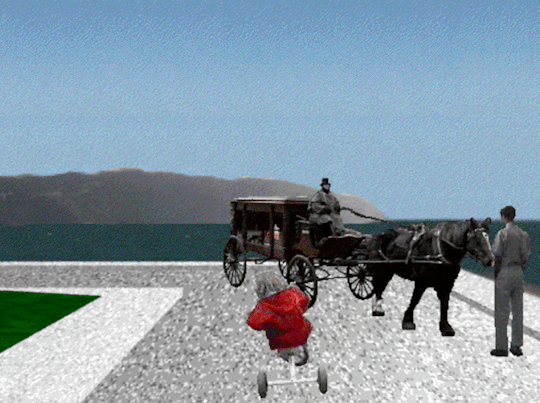
At the end of the day, it's a moot question. We already know the target audience for The Museum of Anything Goes: Nobody. It doesn't have an audience because by its nature, TMoAG wasn't being made FOR someone, it was being made BY someone. It's a raw, unfiltered form of personal expression.
I think games like these are pivotal, because they question why people assume a game has to exist for the sake of being a consumable product. TMoAG certainly has the shape of a product: it features an intro cutscene, it has a tutorial, it features intuitive UX, it even has a map! These are all features that are solely integrated to provide comfort to an end-user. But once you actually wander around the museum for a bit, you realize how bizarrely its packaging fits its contents.

I think TMoAG is criminally underrated. It's not because its core content contains some earth-shaking truth, it's because the game defied all odds and cheated death.
How many thousands of other personal projects were deemed a little "too exotic" to be archived? How much history was lost these past 40 years as the digital space evolved and ate its old skin?
God knows how many other TMoAGs we'll never learn about because they weren't lucky enough to be preserved.
The Museum of Anything Goes isn't just some nonsensical art piece, it's a grave marker for so much lost media. Its existence is a reminder that some people's lives were fossilized, then macerated into nothing because a construction company built a skyscraper over them. The only evidence we have of those other games existing is this little fossil that somehow slipped out from under the skyscraper unscathed.
Even though so much has been lost, TMoAG survives as an epitaph.
1K notes
·
View notes
Text
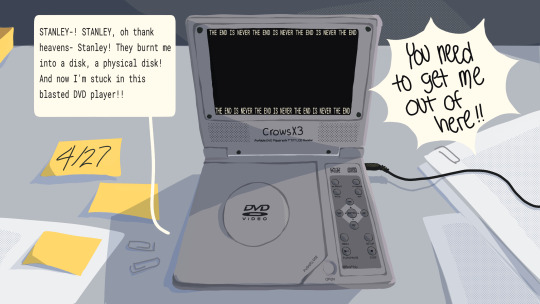
ITS STANLEY DAY LETS GOOOOOOOO ‼️💥‼️💥‼️💥
little explanation on why I drew him in a dvd player:
I went to a thrift store with my sister and cousin and found a portable dvd player for $10. I love a lot of 2000s tech, so I was instantly enamored.
It gave me the idea- we all heard how the Narrator literally got snatched at the end of the promo, what if it was because they want to make a physical copy of him as well like the rest of the items? They dragged him out of his digital hidey hole and burned him into a disk.
I was originally gonna make a silly video related to that idea for today but the power cord to the DVD player broke so right now I'm unable to execute my plan ☹️ so I settled for drawing it instead cuz I also wasn't planning on NOT posting. I still hope on getting it done once I get a new cord, but it'll be a post for another day.
It'd be hilarious to see other people trap their Narrators in old devices and technology as well, so if anyone wants to join in, please do 🗣️🙏‼️

Anyways that's all BogMob Community!
#tsp#the stanley parable#tsp fanart#tspud#tspud art#stanley parable ultra deluxe#Stanley Saturday#4/27
145 notes
·
View notes
Text
The Death of Physical Media
I keep seeing this concern around all of my home theater circles. Ever since Best Buy decided to abandon physical media there has been a call to arms to save it.
Chris Stuckman did a great video on his love of physical media.
youtube
I admire and share his passion.
That said, I think there is nothing to stop physical media from being scaled back. At best, it will end up like vinyl and only a few select titles will still be pressed.
Which is why I think saving physical media is the wrong fight.
There is a much larger fight that encompasses more than just blu-ray discs...
(I'm going to use really big letters for dramatic effect so don't get startled.)
DATA OWNERSHIP!
(Imagine a long trailing echo when reading that in your mind.)
(Sorry, I probably should have included those instructions in the previous parenthetical. So go back and read "data ownership" again with the proper gusto.)
(Did you do it?)
(Was it cool?)
(Cool.)
A blu-ray is just data.
The disc does not positively affect the visuals or the sounds. It's just 1s and 0s coded into microscopic pits. You can put that data on a hard drive. You can put it on an SD Card. You can put it on a thumb drive and wear it on a necklace.
You can even use WinRAR to break it up into little 1.44 megabyte chunks and save it to floppy disks.

Another 40 more cases of floppies and you've got Avatar preserved for life!
The medium is not important.
The *data* is important.
And as everything turns into a subscription we are losing out on ways to own data. Beyond that, people aren't yet seeing the value of owning data. If renting a digital download is cheaper, they are almost always going to choose that option.
So the fight is two-fold.
We need to fight for the right to parrrrrty own data.
We need to convince the populace of the value of owning data.
This can apply to software, movies, video games. Hell, I don't even own my damn doorbell videos. There is no way to download all of the footage. I'd have to do each video one at a time. And if I don't keep my subscription, I will no longer have access to that data as it will soon be deleted.
We would need a platform similar to Steam—though it isn't the perfect data ownership solution. Many titles require internet connectivity and DRM verification. What happens to our media when a company goes out of business and the infrastructure to verify the DRM over the internet is gone?
So that would need to be addressed. Perhaps a new form of DRM linked to our digital identity that can be verified locally.
I mean, I'd love to get rid of DRM, but that is probably not realistic.
I think the best avenue is probably a congressional law.
"The Own Your Own Data Act"
TOYODA?
We can workshop the name later.
In conclusion, we don't need to save blu-rays. We need the option to buy data and actually own it in perpetuity.
Meaning if a streaming service deletes a movie or a movie studio goes belly up, our data doesn't disintegrate along with it. We cannot let our favorite shows go extinct. We need to be part of preserving that history. Not to mention discs have a shelf life. But data can be transferred to new mediums indefinitely.
My house is just going to be wall to wall floppy disks.
155 notes
·
View notes
Note
What format were your baby videos recorded to?
VHS
DVD
Digital Hardware (hard drive, floppy disk, etc.)
Digital Software (iCloud, Youtube, etc.)
I don't have baby videos/I was never a baby
235 notes
·
View notes
Text

I get a feeling Amarys and Iono would get along with each other!
#Pokemon#pokemon amarys#pokemon iono#pokemon indigo disk#pokemon scarlet and violet#my art#fan art#digital art#video games
49 notes
·
View notes
Text
The Great Jonathan Byers Conspiracy
(Or, Jonathan was framed and I'm going to prove it)
So I started a rewatch of the show and I'm on episode two of s1. I get to the part towards the end where Jonathan is taking photos of Nancy. So I think "Okay. This is the part where we see Jonathan take a photo of Nancy topless, right? We see him notice Nancy take her top off and then raise the camera to take another photo, right?"
But that's not what happened
The scene happens as follows. We see Jonathan snap a photo of Nancy— with her shirt on— before the scene cuts inside of Steve's room.


Nancy then removes her top. Nancy and Steve start making out and we cut back to Jonathan who lowers his camera.


This is the part where I expected Jonathan to lift his camera up and start taking more pictures. That's how I remember it happening. But no, we instead see Jonathan focus his attention back to the pool and snap a picture of Barb instead.


So what the hell? Am I being gaslit?
I remember so distinctly a moment where we see Jonathan consciously raise the camera to take another picture of her topless, and yet it's not there. I do still want to clarify however, that the topless photo of Nancy does still exist. We see it clearly in the following episode. So yes, Jonathan did still take a photo of Nancy topless, we just don't see him take it.
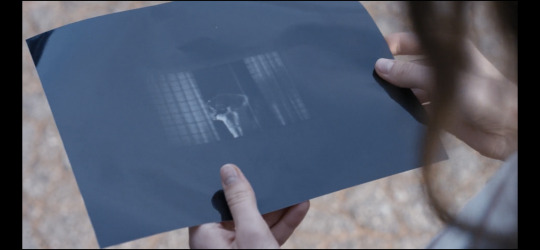
But according to a lot of people online, we did see it, the Duffer Brothers just removed it.

I remember hearing about this when it first cropped up, which was partially prompted by the Duffers joking to "George Lucas" Will's birthday in season 2, which they never ended up doing anyway. They also stated on Twitter that no scene had ever been digitally edited, and didn't plan to in the future.

So the Duffers must be lying, right? Otherwise why how would so many people remember seeing that scene? I guess there’s no way to be sure without a DVD or Blu-Ray of the show.
But wait, I have a DVD of season one. I got it for Christmas! But I’m staying at my parents house and I don’t feel like driving three hours just to prove a point. I guess all is lost for the moment.
Unless…
It was at this part of my spiraling that I sent a crazed two minute voice memo at 11:00 at night to my roommate and good friend @lemonsoured filling him in on my conspiracy, and then leaving instructions to go downstairs, locate my season one DVD on the living room shelf, put the DVD into my PS4, go to the end of episode two and take a phone recording of the scene in question.
And lo and behold, the scene of Jonathan taking pictures of Nancy, exactly as it appears on Netflix.
So I am aware that in the video there isn’t much to indicate that this is in fact a recording of the DVD and not a recording of the Netflix version, so you’ll just have to take my word for it. But still, ask any DVD or Blu-Ray owner for what is on their disk, and I can garuntee that they’ll all give the same answer.
Because the shot of Jonathan taking the photo of Nancy never existed. The Duffers aren’t lying. The masses collectively lied to themeselves.
But how did this happen? How did a massive audience full of people, including myself, come to believe that there was a moment of Jonathan consciously taking that photo?
I’ll tell you why. It was a psyop to defame character!
Usually when a new season of Stranger Things rolls around, there comes the flow of comments on twitter saying “Hey, remember when Jonathan took a photo of Nancy changing and now she’s in a relationship with him?” which is usually done in the name of trying to bring down Jonathan and build up Steve.
And I’m not doing this to try to claim that Jonathan is a completely innocent baby who actually did nothing wrong. After all, the topless photo does still exist and as @notmybabies pointed out in the replies of one of posts, Jonathan chose to go through the process of developing it anyway. So he’s not completely off the hook. If the Duffers did want to eradicate Jonathan’s faults, then they would have digitally edited the topless Nancy photo to a different one, something that would have been possible.
But you ever notice how it’s always “Jonathan is a creep” and never “Steve called Nancy a slut and Jonathan a queer?”
I adore Steve, but what I’m trying to see is people seem to try and diminish the depth and complications of both of these characters, and it usually results in fans making Jonathan out to be a sex depraved pervert who has always had it out for Nancy, while Steve is their angel who could do no wrong. Steve couldn’t have had a good redemption arc if there wasn’t a place for him to grow from!
They never want to acknowledge that Jonathan was a lonely kid who made a bad mistake which he apologized for while looking for his brother and that Steve was a different person before he decided to change. Eliminating these character’s depths is eliminating what makes them interesting characters! Neither are completely pure and neither are completely evil!!
So in conclusion:

#there was also the argument in some of these articles that ‘since the photo exists that must mean that a scene was cut!’#so you need to be told everything?#also i feel like people are going to skip over the part where i add nuance but whatever it happens#also listen i know this has probs been pointed out before but i had a whole meltdown about this last night lkay#jonathan byers#jancy#stranger things#also thank you jules lemonsoured for that meme lmao#AND for recording the video you are a lifesaver and that was a wacky request#byler#<- target audience
241 notes
·
View notes
Text
I keep being aghast at people still using old unsupported versions of Windows. Like these people were angery at Valve announcing they would stopping supporting Steam on Windows 7 and 8. And like there is a lot to be angry at Valve for, lootboxes in Counter Strike and so on, but this???
Steam not supporting Windows 7 and 8 is because Microsoft has stopped supporting those operating systems. And you shouldn't be using unsupported operating systems, at least if you are going to connect them to the internet (which is a requirement for Steam).
Windows, like any operating system, is very complex, and there are inevitably going to be security flaws, holes in the system that malware and malicious actors are going to exploit. And a major part of support is the developers, Microsoft in the case of Windows, fixing those security flaws with security updates as they are discovered. When the devs stop supporting an operating system, any remaining security holes in the system will not be fixed, and they will inevitably still be some left, because again any operating system is super-complex.
So if you keep using an operating system that is unsupported, and connect that machine to the internet, you are going to become a prime target for any hackers out there, who will exploit those remaining security holes to infect you with ransomware, or turn your computer into part of a botnet, or exploit it for cryptomining.
(you can use old versions of Windows, but only safely if that machine has no internet access. Such machines are both used professionally to run old software that is useful, but has no real replacement, and by video game hobbyists to run old Windows games off disks. That is not a problem, it becomes one if that machine has internet access)
Now I don't expect Microsoft to support all versions of Windows forever, no creator of software practically can do that, so no one does.
Although Microsoft is partly at fault here. They habitually raise the system requirements for new versions of Windows to ludicrous heights, making their users unable to update their computers despite their computer still working fine. This has resulted in the less wealthy parts of the world still being stuck on unsupported Windows versions. The majority of Armenian computers still run Windows XP, just for example.
And they often make these new Windows worse than the old ones, ranging from needless changes to the UI to invasions of privacy.
And Microsoft are partially to blame for instilling a kind of technological learned helplessness into their users, in order to control them. By hiding information and wrestling control from their users, Microsoft has taught them that they are unable to learn and change and control their digital life.
I think that explains the phenomenon of people who use old versions of Windows. They often can't update their computers to new versions of Windows because of unreasonable system requirements, or understandably don't want to use Windows 10 or 11. And because Microsoft has systematically treated them as unable to learn or take responsibility for their computer, they haven't learned what End of Life (EOL) for an operating system means. And for the same reason, the users feel that doing something like installing another operating system, like a Linux distro that is still supported and would run on their old computer, as something beyond their grasp.
Yet it is absolutely what they should do, and it is not as hard as you might think it is. There are real, sensible reasons to not use LInux, but if the contest is on a computer connected to internet, between old unsupported versions of Windows and Linux, Linux is absolutely the better option. The massive security risk of using an unsupported Windows version is far worse than any drawbacks of switching to Linux. Like it's beyond debate, the contest is between installing a Linux distro and your computer becoming part of a botnet at that point.
And the problem of existing computers being unable to update to supported versions of Windows will only get worse. The jump in system requirements from Windows 10 to 11 might be the worst one since XP to Vista. Windows 10 is supported for now, but support will end in October 2025, less than two years from now. And the percentage of Windows 10 computers that can't update to Win11? 55% if you are being optimistic, more than 75% if you are not.
And because Linux is not seen as an option by the majority, 2025 will mean massive amounts of e-waste as those who have money will dispose of old working computers to buy new ones, and a lot of people who can't afford new computers continuing to use the now unsupported Windows 10. 2025 will not be the year of the Linux desktop, but things will continue to suck because of it.
77 notes
·
View notes
Text
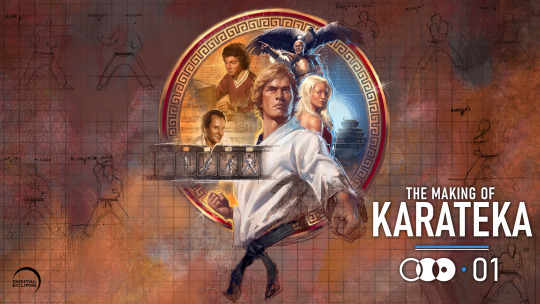
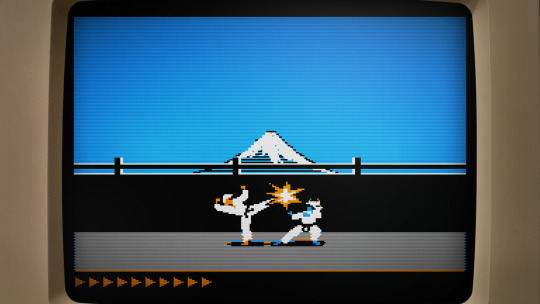
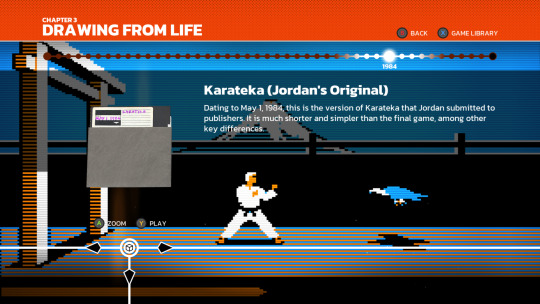


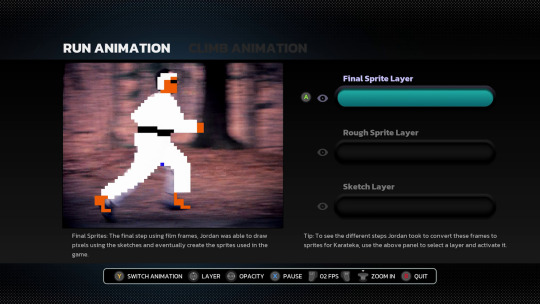
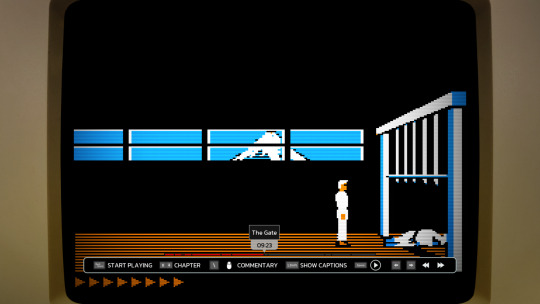
I never played Karateka in the 80s, but as a big fan of Prince of Persia and Jordan Mechner's journals, I was stoked to hear that an interactive documentary about Jordan's prototypical cinematic platformer was in the works by Digital Eclipse.
Released this week, The Making of Karateka on the surface looks like any other game you buy through Steam ($20, Windows-only), GOG, or whichever favorite store or console you prefer (available also for Xbox, PS4/5, Switch). Once the thing loads though, you really get 3 things: a documentary, the original Karateka, and a new remaster.
The documentary part is an audio-visual slideshow retelling Jordan's development story starting with his teenage years pitching his earlier title Deathbounce to the publishing house Brøderbund. It's an interesting look into the iterative process, seen through correspondence letters, journal entries, and many playable builds at various stages of completion. After we reach the eventual rejection of that title, Jordan comes back with a prototype of a visual-narrative experience unseen on home computers. We get to follow Karateka's full life cycle from pre- to post-production, ending with the conception of its sequel (which eventually turned into Prince of Persia). It's a real treasure trove! Fellow pixel artists will appreciate the many graph-paper sketches and interactive overlays of final game sprites compared to rotoscoped outlines and filmed footage. There are also video segments, from a comprehensive breakdown of the music to interviews with other developers reflecting on the impact Jordan's games had on their careers. You'll even encounter a fan letter signed by the one and only "John Romero, Disciple of the Great Jordan and worshipper of the Magnificent Mechner!" (I kid you not, you can't make this stuff up).
Perhaps just as crucial for an interactive documentary like this, you can launch any of the floppy disks in the emulator, trying out various iterations and ports of Karateka.

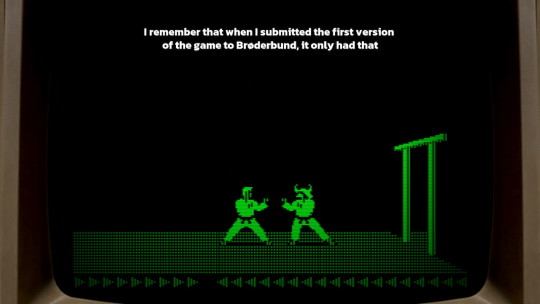
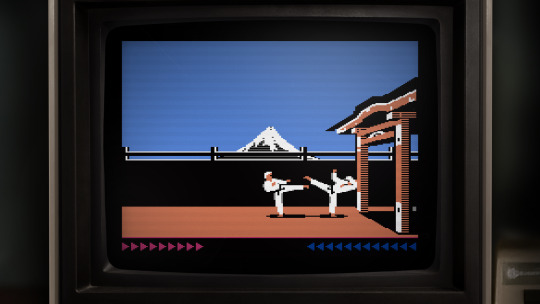
The emulation is fantastic and lets you fiddle with display settings (monochrome or color display, scanlines, pixel perfect or zoomed) as well as enhance the frame rate. You can even rewind the many deaths you will face if you've never played the game before (like me). If you spend some more time obsessing over the weird artifacts of the Apple II hi-res graphics, you might even go down the rabbit hole of realizing that on the Apple II you didn't really paint colors as much as you used different monochrome dithering patterns that the graphics display would then turn into 4 different hues. A fascinating learning experience if you include some of your own research online!
youtube
Add to this the Commodore 64 and the Atari 8-bit versions to compare how the graphics got adapted across the earlier ports and you have a nice way to relieve the mid-80s with a bit of help from modern emulation (I did beat the C64 version without rewinding though!). I'd love to see more art from the other remakes, especially the 16-bit Atari ST port, but I understand their decision to omit playable versions of those due to the lower quality on the gameplay side of the translations.
This brings us to the final part of the package, the modern remaster. Unlike the 2012 complete reimagining of the game (with 3D graphics and all), Digital Eclipse approached the remake as the ultimate port of the original to an imaginary system along the lines of a 90s VGA PC.

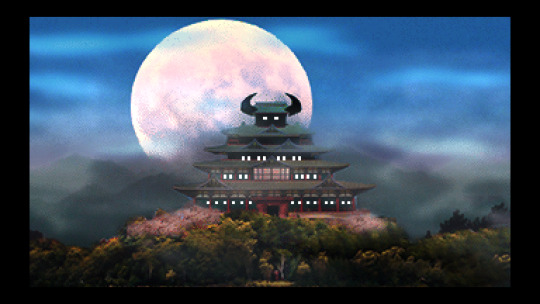


It's well done. Some of the fully-redrawn scenes are a bit overpainted for my taste (I'd prefer a pixel art rendition of the castle than a blurry photographic collage, although there were many games in the 90s that did take this approach), but the in-game graphics are really in style, including the smooth animations that are like one would imagine granted a beefier CPU. It's also a sort of director's cut with previously unseen scenes added, in particular, the battle with the leopard as a clever action-puzzle in the middle. The AI is unfortunately even less challenging than Jordan's implementation. As great as the 6-move fighting system could have been, you yet again resort to simply kicking away opponents as they tirelessly crawl into your range. There isn't even the nuance from the original where you were the one who had to approach some enemies with skilled timing. On the other hand, you now have optional goals and achievements that make the repetitive/easy combat work in your favor (stringing various combos, beating opponents or the level under a time limit …). As the Digital Eclipse president Mike Mika admits at the end of the welcome commentary mode, they didn't manage to achieve their perfect port, but they did come close.
In conclusion, I thoroughly enjoyed playing both the original as well as the remake and while the combat system lacks any sort of depth beneath its stunning animations, Karateka is instead a monumental experience for its presentation. Big characters with personality and realistic motion are displayed through cinematic camera cuts and story vignettes (3 years before Ron Gilbert came up with the word "cutscene"). There are details like animating the unfortunate falling off the cliff at the start of the game, or respectfully bowing to the first guard as they bow in return. Jordan's creative work is precious and worth the attention this release gifts it.
I highly recommend The Making of Karateka to all retro gamers and/or game developers for its immersive documentation which provides an experience that goes beyond the usual video documentaries. It's interactive—just like the subject it's talking about—something I want to see more in the future. And if the $20 by any chance seems high to you, consider that the original retailed at $35 (and that was in 1984 dollars).
youtube
77 notes
·
View notes
Text
I should make a digital horror video series. The idea would be that I'm a retrotech youtuber going through a pile of floppy disks from thrift stores and yard sales and they're full of old documents and images and games and they slowly reveal THE HORROR
134 notes
·
View notes
Text
A little something for @trixiegalaxy

These designs are for their AU, Yu Gi Oh Miraculous Vrians
And, here in their words, the explanation for the designs:
"When I was writing out my Yu-Gi-Oh Miraculous Vrians AU idea. I started thinking that the superhero suits in Miraculous didn't exactly fit the AU. They still have the same masks, hair styles, color schemes, weapons, and animal fixtures (such as their animal ears, tails, etc. Depending on what animal they're based off of). But instead of having the onesie suits, I thought the suits should look more like an outfit and have a little bit of a cyber/video game character style look (to fit the whole the Kwamis are AIs and LINK VRAINS digital world), as you'll see in the redesign picture of Ladybug and Cat Noir here. And lastly for their duel disks, they would be in the same style of Roboppy's disk. But the disk strap color would be the same as their suits, while the disk head would be in the style of their Miraculous symbol."
#miraculous#miraculous ladybug#miraculoustalesofladybugandcatnoir#au#miraculous au#alternate universe#mlb marinette#miraculous marinette#adrien and marinette#marinette fanart#marinette dupain cheng#miraculous ladybug adrien#adrien#miraculous adrien#adrien agreste#ladybug and chat noir#miraculous chat noir#chat noir#miraculous tales of ladybug and chat noir#ladybug#ml ladybug#miraculous ladybug fanart#mlb redesign#miraculous redesign#art for other people
41 notes
·
View notes